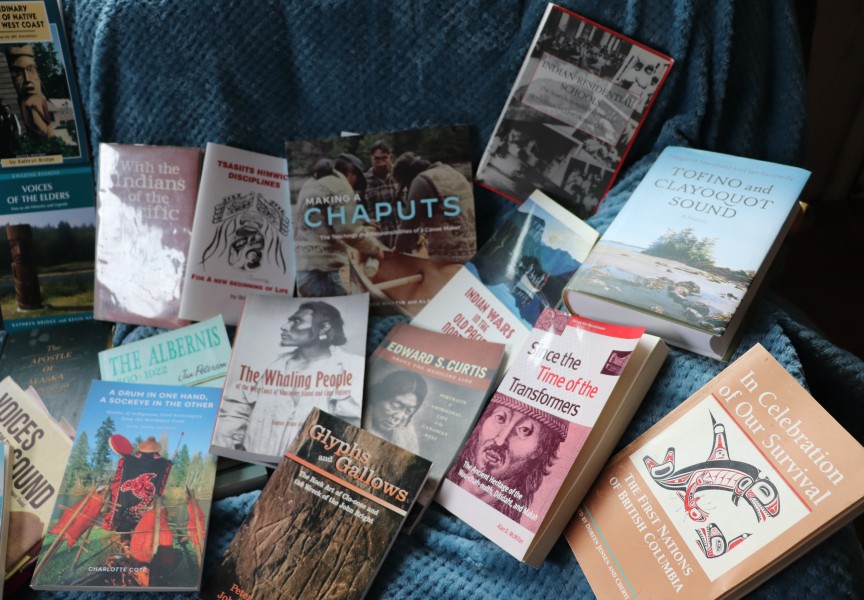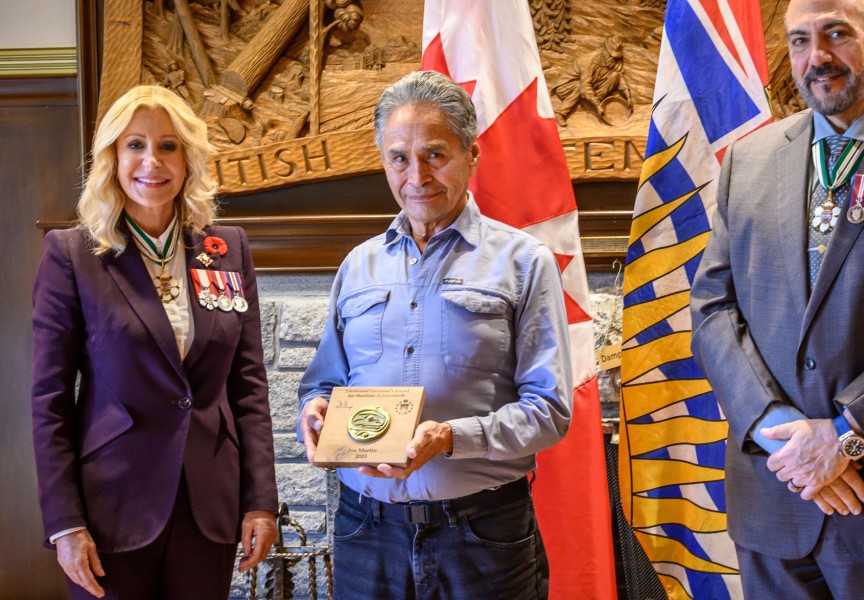An exhibition celebrating the life and legacy of Tseshaht artist, writer, and cultural leader George Clutesi is set to officially open this month at the University of Victoria’s Legacy Art Gallery. Building on the acclaimed exhibit held at the Alberni Valley Museum in 2023, this new presentation expands the narrative to include never-before-seen works, intergenerational reflections, and contemporary artistic responses from across the Nuu-chah-nulth world.
While the Port Alberni exhibit centered on Clutesi’s role as a cultural leader within his community, the UVic retrospective broadens the lens, highlighting his contributions to art, literature, and cultural resilience. Dr. Andrea Walsh, an associate professor and Smyth chair in Arts and Engagement in UVic’s Department of Anthropology, has helped curate this ambitious exhibition.
“We didn’t attempt to cover his entire life—we don’t dive deeply into his amazing movie career or his work as an advocate and political figure,” Walsh explains. “Instead, we focus on his contributions to art, and the ways in which his artwork intersected with human rights and cultural policy.”
The exhibit includes pieces from multiple institutions across British Columbia, including UVic, UBC, the Royal BC Museum, and the Alberni Valley Museum. It also showcases art brought in by members of the public from private collections, as well as deeply personal items from the Clutesi family—ranging from large-scale oil paintings to the original manuscript of his iconic book Potlatch.
“What makes this exhibit unique is the presence of the Clutesi family’s own contributions—art their father and grandfather created, and items that reflect his influence and humanity,” says Walsh.
Clutesi, who rose to national and international recognition through his art and writing, including his participation in Expo 67, remains a towering figure in the history of Indigenous cultural expression in Canada. Yet his most profound legacy, Walsh says, may lie in the personal connections and inspiration he sparked in others.
“It’s an interesting show because it also reflects the people he impacted,” she notes. “His art has been valued through time, by Indigenous and non-Indigenous audiences alike.”
The retrospective includes artwork spanning from the 1920s to the present, showcasing the arc of Clutesi’s creative output alongside new pieces by emerging and established Nuu-chah-nulth artists. Among these are works by UVic-based Nuu-chah-nulth scholars and artists who were asked to read Clutesi’s writing and respond creatively. Walsh says that Ehattesaht scholar Dr. Dawn Smith created a hand-made shawl in tribute, while Huu-ay-aht scholar, Dr. Tommy Happynook, contributed a series of painted drums inscribed with a poem to Clutesi.
“This is a show that is retrospective and grounded in historical work, but it also branches out into the present,” says Walsh. “It’s about legacy, influence, and intergenerational connection.”
A particularly moving component of the exhibit is a new documentary film created in collaboration with survivors of the Alberni Indian Residential School (IRS), where Clutesi once worked as a custodian. For over 13 years, Walsh and her team have partnered with survivors and their families to repatriate artwork created by children at the IRS. In the film, survivors reflect on their memories of Clutesi not just as an artist, but as a source of quiet strength and comfort during an era of profound trauma.
Mark Atleo, a survivor of Alberni IRS who contributed to the documentary, recalls Clutesi’s gentleness and cultural knowledge.
“He was very knowledgeable in our culture—he taught lots of songs, different stories,” Atleo remembers. “He was a custodian, and he gave us a way to stay out of the way of the supervisors. He was very patient with teaching art. It was different art than mine, but I really enjoyed watching and listening.”
The exhibit also features rare archival materials, including a signed copy of Potlatch Clutesi gave to a student named Robert Allard, yet another trace of the personal bonds he formed with the children he worked with and mentored.
Ultimately, the UVic art exhibition is more than a gallery display; it is a living testimony to the enduring power of cultural leadership, artistic expression, and community memory. Through original works, oral histories, and the voices of new generations, the exhibition honours Clutesi not only as a foundational figure in Nuu-chah-nulth art, but as a compassionate presence who left a profound mark on all who encountered him.
“George Clutesi was inspirational,” Atleo says. “He was connected to our people, and he gave a lot to us.”
"He changed life for our people. He is the one who got the potlatch ban lifted. Everything he did, he only did to change the future for his grandchildren,” said family spokesperson Ann Robinson. “We know everything is connected and Uncle George knew how to teach that, he was a writer, an actor, a dancer, a singer, a historian. He was one of the anchors of our people.”
According to Robinson, this marks the third time the exhibit has been showcased; first in Port Alberni, where it ran for two years, followed by a year-long display at the Bill Reid Gallery.
It is now set to open at the University of Victoria, with a soft opening having occurred on April 15, 2025. Participating artists include Hjalmer Wenstob (Tla-o-quiaht), Timmy Masso (Tla-o-quiaht), Marika Swan (Tla-o-quiaht), and Petrina Dezall (Mowachaht/Muchalaht). Participating University of Victoria scholars are Dr. Dawn Smith (Ehattesaht) and Dr. Tommy Happynook (Huu-ay-aht).
The exhibit will be open to the public as of April 16th at 10 AM. The gallery hours are Wednesday to Saturday 10-4 PM. The gallery is free to the public. The Legacy will have an official opening for this exhibit on the day of May 8, 2025, from 1-3 PM, and this event is also free and open to the public. The Legacy Art Gallery is located at 630 Yates St. in Victoria.









